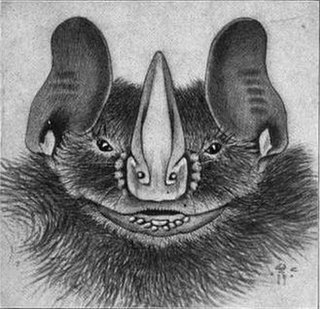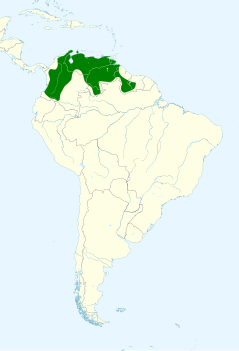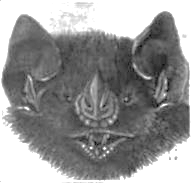
The New World leaf-nosed bats (Phyllostomidae) are found from southern North America to South America, specifically from the Southwest United States to northern Argentina. They are ecologically the most varied and diverse family within the order Chiroptera. Most species are insectivorous, but the phyllostomid bats include within their number true predatory species and frugivores. For example, the spectral bat, the largest bat in the Americas, eats vertebrate prey, including small, dove-sized birds. Members of this family have evolved to use food groups such as fruit, nectar, pollen, insects, frogs, other bats, and small vertebrates, and in the case of the vampire bats, even blood.

The Jamaican, common or Mexican fruit bat is a fruit-eating bat native to Mexico, through Central America to northwestern South America, as well as the Greater and many of the Lesser Antilles. It is also an uncommon resident of the Southern Bahamas. Populations east of the Andes in South America are now usually regarded a separate species, the flat-faced fruit-eating bat. The distinctive features of the Jamaican fruit bat include the absence of an external tail and a minimal, U-shaped interfemoral membrane.

The brown fruit-eating bat is a bat species from South America. It is found in Brazil, Colombia, Ecuador, French Guiana, Guyana, Peru, Suriname and Venezuela.

The fringed fruit-eating bat, is a species of bat native to South America.

The great fruit-eating bat is a bat species in the family Phyllostomidae from South and Central America. It is found from Mexico to Brazil and Argentina, as well as in Antigua and Barbuda, Barbados, Grenada, Martinique, Saint Lucia, Saint Vincent and the Grenadines and Trinidad and Tobago.

The dark fruit-eating bat, is a bat species from South America.

Andersen's fruit-eating bat is a bat species from South America. It is found in Bolivia, Brazil, Colombia, Ecuador, French Guiana, and Peru.

The silver fruit-eating bat is a South American bat species of the family Phyllostomidae.

The gnome fruit-eating bat is a bat species from South America. It is found in Bolivia, Brazil, Colombia, Ecuador, French Guiana, Guyana, Peru, Suriname and Venezuela. This species was originally discovered to be different from the other known species of fruit bats, but later, in 1994 were mistakenly grouped under Artibeus cinereus as a synonym. However, this has since been corrected by more closely studying their physical differences and by biomolecular analysis.

Dermanura is a genus of leaf-nosed bats.

The Neotropical fruit bats (Artibeus) are a genus of bats within the subfamily Stenodermatinae. The genus consists of 12 species, which are native to Central and South America, as well as parts of the Caribbean.

The large fruit-eating bat is a species of bat in the family Phyllostomidae. It is found in the South American neotropics, specifically in the countries of Colombia, Guyana, and Venezuela. The large fruit-eating bat is one of only a few microbats that engages in the eating of leaves.

The Honduran fruit-eating bat is a species of bat in the family Phyllostomidae. It is found in El Salvador, Honduras, and Nicaragua.

The flat-faced fruit-eating bat is a South American species of bat in the family Phyllostomidae. It is sometimes considered a subspecies of the Jamaican fruit bat, but can be distinguished by its larger size, the presence of faint stripes on the face, and of a third molar tooth on each side of the upper jaw. Genetic analysis has also shown that the two species may not be closely related.

The Toltec fruit-eating bat is a species of bat in the family Phyllostomidae. It is also sometimes called the "lowland fruit eating bat."

The velvety fruit-eating bat, also known as Hart's little fruit bat, is a species of bat in the family Phyllostomidae. It is monotypic within the genus Enchisthenes. It is found in Central America, Mexico, the United States, and northern South America.

Stenodermatinae is a large subfamily of bats in the family Phyllostomidae.

Thomas's fruit-eating bat, sometimes also popularly called Watson's fruit-eating bat, is a species of bat in the family Phyllostomidae. It is found from southern Mexico, through Central America to Colombia. Its South American range is to the west of the Andes. The species name is in honor of H. J. Watson, a plantation owner in western Panama who used to send specimens to the British Natural History Museum, where Oldfield Thomas would often describe them.
The Bogota fruit-eating bat is a species of bat found in South America.
Dermanura rava is a species of leaf-nosed bat found in Central and South America.














